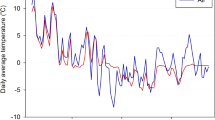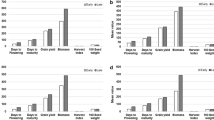Abstract
Knowledge of the time required for the initiation of flowering is important for chickpea adaptation in environments like western Canada, not only because flowering is a vulnerable stage of development but also it is a major factor affecting variation in crop duration. Temperature and photoperiod are the major environmental factors that determine time to flowering in many major crops. One hundred diverse chickpea accessions were examined under long-day (16/8 H day and night, respectively) and short day (10/14 H day and night, respectively) photoperiods for their flowering response. The temperature in the chambers was adjusted to 22/16 °C (day and night, respectively). Variability among the accessions for days to flowering, photoperiod sensitivity (defined as the delayed number of days to flowering under short-day photoperiod treatment as compared to long-day photoperiod treatments), and node number of first flowering under short and long-day photoperiods was detected. Four accessions were classified as photoperiod-insensitive, 49 as intermediate response, and 47 as highly photoperiod-sensitive based on their flowering response to photoperiod. A significant (r = 0.92, P ≤ 0.0001) positive correlation was observed between days to flowering under short-days and photoperiod sensitivity. In photoperiod-insensitive accessions fewer degree days were required for flowering as compared to intermediate and highly photoperiod sensitive ones. Under long-day photoperiod, the photo-thermal and thermal units required to initiate flowering accumulate faster. Thus photoperiod-insensitive accessions required fewer accumulated thermal and photo-thermal units.


Similar content being viewed by others
Abbreviations
- CDC:
-
Crops Development Centre
- DD:
-
Degree days
- H:
-
Hours
- LD:
-
Long-days
- PS:
-
Photoperiod sensitivity
- SD:
-
Short-days
- Tu:
-
Thermal units
- °C:
-
Degree celsius
- g:
-
Gram
- l:
-
Litre
- µmol:
-
Micromole
- M:
-
Metre
- S:
-
Second
- °N:
-
Degrees north
- °S:
-
Degrees south
- W:
-
Watt
References
Aitken Y (1955) Flower initiation in pasture legumes. I. Factors affecting flower initiation in Trifolium subterraneum L. Crop Pasture Sci 6:211–244
Anbessa Y, Warkentin TD, Vandenberg A, Ball R (2006) Inheritance of time to flowering in chickpea in a short-season temperate environment. J Hered 97:55–61
Anbessa Y, Warkentin TD, Bueckert R, Vandenberg A (2007) Short internode, double podding and early flowering effects on maturity and other agronomic characters in chickpea. Field Crops Res 102:43–50
Berger JD, Ali M, Basu PS, Chaudhary BD, Chaturvedi SK, Deshmukh PS, Dharmaraj PS, Dwivedi SK, Gangadhar GC, Gaur PM, Kumar J, Pannu RK, Siddique KHM, Singh DN, Singh DP, Singh SJ, Turner NC, Yadava HS, Yadav SS (2006) Genotype by environment studies demonstrate the critical role of phenology in adaptation of chickpea (Cicer arietinum L.) to high and low yielding environments of India. Field Crops Res 98:230–244
Berger J, Milroy S, Turner N, Siddique K, Imtiaz M, Malhotra R (2011) Chickpea evolution has selected for contrasting phenological mechanisms among different habitats. Euphytica 180:1–15
Chang TT, Li CC, Vergara BS (1969) Component analysis of duration from seeding to heading in rice by the basic vegetative phase and the photoperiod-sensitive phase. Euphytica 18:79–91
Cheng L, Wang Y, Zhang C, Wu C, Xu J, Zhu H, Leng J, Bai Y, Guan R, Hou W (2011) Genetic analysis and QTL detection of reproductive period and post-flowering photoperiod responses in soybean. Theor Appl Genet 123:421–429
Coupland G (1995) Genetic and environmental control of flowering time in Arabidopsis. Trends Genet 11:393–397
Croser J, Ahmad F, Clarke H, Siddique K (2003) Utilisation of wild Cicer in chickpea improvement, progress, constraints, and prospects. Crop Pasture Sci 54:429–444
Cutforth HW, McGinn SM, McPhee KE, Miller PR (2007) Adaptation of pulse crops to the changing climate of the northern Great Plains. Agron J 99:1684–1699
Dwivedi S, Perotti E, Ortiz R (2008) Towards molecular breeding of reproductive traits in cereal crops. Plant Biol J 6:529–559
Ellis R, Collinson S, Hudson D, Patefield W (1992) The analysis of reciprocal transfer experiments to estimate the durations of the photoperiod-sensitive and photoperiod-insensitive phases of plant development: an example in soya bean. Ann Bot 70:87–92
FAOSTAT (2013) FAOSTAT-statistical database, 2013. Accessed 4 Aug 2014
Gan YT, Miller PR, McConkey BG, Zentner RP, Stevenson FC, McDonald CL (2003) Influence of diverse cropping sequences on durum wheat yield and protein in the semiarid northern Great Plains. Agron J 95:245–252
Holland J, Portyanko V, Hoffman D, Lee M (2002) Genomic regions controlling vernalization and photoperiod responses in oat. Theor Appl Genet 105:113–126
Jamalabadi JG, Saidi A, Karami E, Kharkesh M, Talebi R (2013) Molecular mapping and characterization of genes governing time to flowering, seed weight, and plant height in an intraspecific genetic linkage map of chickpea (Cicer arietinum L.). Biochem Genet 51:387–397
Kamran A, Iqbal M, Spaner D (2014) Flowering time in wheat (Triticum aestivum L.): a key factor for global adaptability. Euphytica 197:1–26
Kumar J, Abbo S (2001) Genetics of flowering time in chickpea and its bearing on productivity in semiarid environments. Adv Agron 72:107–138
Ladizinsky G, Adler A (1976) The origin of chickpea (Cicer arietinum L.). Euphytica 25:211–217
Levy YY, Dean C (1998) The transition to flowering. Plant Cell 10:1973–1990
McMaster GS, Wilhelm WW (1997) Growing degree-days: one equation, two interpretations. Agric For Meteorol 87:291–300
Mei D, Wang H, Hu Q, Li Y, Xu Y, Li Y (2009) QTL analysis on plant height and flowering time in Brassica napus. Plant Breed 128:458–465
Nelson MN, Berger JD, Erskine W (2010) Flowering time control in annual legumes: prospects in a changing global climate. CAB Rev 5:e14
Okumoto Y, Ichitani K, Inoue H, Tanisaka T (1996) Photoperiod insensitivity gene essential to the varieties grown in the northern limit region of paddy rice (Oryza sativa L.) cultivation. Euphytica 92:63–66
Or E, Hovav R, Abbo S (1999) A major gene for flowering time in chickpea. Crop Sci 39:315–322
Paton DM, Barber HN (1955) Physiological genetics of Pisum. Aust J Biol Sci 8:231–240
Purushothaman R, Upadhyaya HD, Gaur PM, Gowda CLL, Krishnamurthy L (2014) Kabuli and desi chickpeas differ in their requirement for reproductive duration. Field Crops Res 163:24–31
Reeves PH, Coupland G (2000) Response of plant development to environment: control of flowering by day length and temperature. Curr Opin Plant Biol 3:37–42
Roberts E, Hadley P, Summerfield R (1985) Effects of temperature and photoperiod on flowering in chickpeas (Cicer arietinum L.). Ann Bot 55:881–892
Roberts E, Summerfield R, Ellis R, Qi A (1993) Adaptation of flowering in crops to climate. Outlook Agric (United Kingdom)
Sandhu SS, Hodges HF (1971) Effects of photoperiod, light intensity, and temperature on vegetative growth, flowering, and seed production in (Cicer arietinum L.). Agron J 63:913–914
SAS Institute (2009) SAS-statistical analysis software for Windows version 93. SAS Inst. Inc., Cary
Sethi SC, Byth DE, Gowda CLL, Green JM (1981) Photoperiodic response and accelerated generation turnover in chickpea. Field Crops Res 4:215–225
Singh K (1997) Chickpea (Cicer arietinum L.). Field Crops Res 53:161–170
Snape JW, Butterworth K, Whitechurch E, Worland AJ (2001) Waiting for fine times: genetics of flowering time in wheat. Euphytica 119:185–190
Soltani A, Torabi B, Zeinali E, Sarparast R (2004) Response of chickpea to photoperiod as a qualitative long-day plant. Asian J Plant Sci 3:705–708
Soltani A, Hammer GL, Torabi B, Robertson MJ, Zeinali E (2006) Modeling chickpea growth and development: phenological development. Field Crops Res 99:1–13
Summerfield RJ, Roberts EH (1988) Photo-thermal regulation of flowering in pea, lentil, faba bean and chickpea. In: Summerfield RJ (ed) World crops: cool season food legumes. Kluwer, Dordrecht, pp 911–922
Summerfield RJ, Roberts EH, Ellis RH, Lawn RJ (1991) Towards the reliable prediction of time to flowering in 6 annual crops. I. The development of simple models for fluctuating field environments. Exp Agric 27:11–31
Summerfield RJ, Asumadu H, Ellis RH, Qi A (1998) Characterization of the photoperiodic response of post-flowering development in maturity isolines of soyabean [Glycine max (L.) Merrill]‘Clark’. Ann Bot 82:765–771
Trudgill DL, Honek A, Li D, Straalen NMV (2005) Thermal time-concepts and utility. Ann Appl Biol 146:1–14
Tsubokura Y, Matsumura H, Xu M, Liu B, Nakashima H, Anai T, Kong F, Yuan X, Kanamori H, Katayose Y (2013) Genetic variation in soybean at the maturity locus E4 is involved in adaptation to long days at high latitudes. Agronomy 3:117–134
Vadez V, Berger JD, Warkentin TD, Asseng S, Ratnakumar P, Rao KPC, Gaur PM, Munier-Jolain N, Larmure A, Voisin AS, Sharma HC, Pande S, Sharma M, Krishnamurthy L, Zaman-Allah M (2012) Adaptation of grain legumes to climatic change: a review. Agron Sust Dev 32:31–44
Van der Maesen LJG (1972) Cicer L., a monograph of the genus, with special reference to the chickpea (Cicer arietinum L.), its ecology and cultivation. Ph.D thesis. Agricultural University of Wageningen, Agricultural college information bulletin. Wageningen, pp 72–110
Wallace D, Zobel R, Yourstone K (1993) A whole-system reconsideration of paradigms about photoperiod and temperature control of crop yield. Theor Appl Genet 86:17–26
Warkentin TD, Vandenberg A, Banniza S, Tar’an B, Tullu A, Lulsdorf MM, Kumar J (2003) Breeding chickpea for improved ascochyta blight resistance and early maturity in western Canada. In Proceedings of international chickpea conference, Indira Gandhi Agricultural University, pp 20–22
Warner RM (2009) Determination of photoperiod-sensitive stages of development of the short-day plant Celosia. Hort Sci 44:328–333
Worland AJ (1996) The influence of flowering time genes on environmental adaptability in European wheats. Euphytica 89:49–57
Yourstone K, Masaya P, Zobel R (1993) Photoperiod gene control over partitioning between reproductive and vegetative growth. Theor Appl Genet 86:6–16
Zentner RP, Wall DD, Nagy CN, Smith EG, Young DL, Miller PR, Campbell CA, McConkey BG, Brandt SA, Lafond GP, Johnston AM, Derksen DA (2002) Economics of crop diversification and soil tillage opportunities in the Canadian prairies. Agron J 94:216–230
Zhang L, Wang R, Hesketh JD (2001) Effects of photoperiod on growth and development of soybean floral bud in different maturity. Agron J 93:944–948
Acknowledgments
The authors thank the Saskatchewan Ministry of Agriculture for financial support of this research (ADF #2009-0330). The technical expertise of Brent Barlow, the Crop Sciences Field Lab staff, and the phytotron staff is highly appreciated.
Author information
Authors and Affiliations
Corresponding author
Ethics declarations
Conflict of interest
The authors declare that they have no conflict of interest.
Rights and permissions
About this article
Cite this article
Daba, K., Tar’an, B. & Warkentin, T.D. Flowering response of diverse chickpea (Cicer arietinum L.) accessions to photoperiod. Genet Resour Crop Evol 63, 1161–1172 (2016). https://doi.org/10.1007/s10722-015-0308-5
Received:
Accepted:
Published:
Issue Date:
DOI: https://doi.org/10.1007/s10722-015-0308-5




